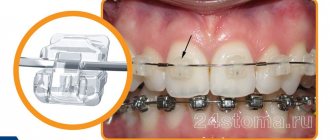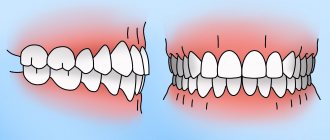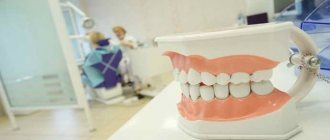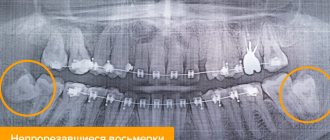Reading time 7-8 minutes
Author of the article: Tsurkan Victoria Olegovna
Specialization: Dentist-orthodontist
Total work experience: since 2015
- Stages of defect correction and expected results
- How long should you wear traction braces?
- Brief summary
When deciding on the use of orthodontic structures, patients are often interested in how long they wear braces on their teeth. Since the timing is determined individually, it is important to answer the question of what affects the duration of wear and what results to expect during the treatment process and after its completion.
Five factors that influence how long you wear braces
The total time that patients wear braces is 1-3 years. How many months or years it will take in your case can only be predicted by an orthodontist (after examination and medical history). In advance, you can independently calculate the approximate time for which the structures are worn, taking into account five main factors:
- Patient's age.
- Type and complexity of violations.
- Type of bracket system.
- Qualification of an orthodontist.
- Care and implementation of recommendations.
Each of the factors has its own characteristics, which are worth considering in more detail.
Patient age
The specific time of use after installing braces is determined based on the clinical picture and individual characteristics of the jaw structure. But, you can rely on average data that is natural for different ages of patients:
- Children
. Due to the pliability of the dentofacial apparatus, which occurs at the age of 12-16 years, all processes to correct the bite occur quite quickly. Most often, 0.5-1 year is enough to correct moderate severity. - Teenagers
. During the period of active formation of the dental system, you can count not only on the effectiveness of the result, but also on the minimum time to achieve it. On average, adolescents aged 18-23 years need 3-8 months less to achieve the desired result than older patients. - Adults
. Since in an adult the dentofacial apparatus is already fully formed, regenerative processes in tissues are slowed down and the rate of metabolic processes decreases, orthodontic treatment will take 2-3 years.
The question of how long braces should be worn may also arise in older people - the use of these orthodontic structures can be shown as one of the preparatory stages before prosthetics. In this case, you will have to wear braces for several years.
Type and complexity of violations
Braces can solve a number of problems with bite and uneven teeth. Depending on the reasons why you are installing orthodontic structures and the severity of the defect, the time for using braces may vary:
- Alignment of one or more teeth
. If it is necessary to shift (change the position) of units in a row, you will have to wear braces for an average of 1.5 years. - Elimination of distal bite
. This pathology can be diagnosed with different stages of complexity. Depending on the severity of the defect, wearing orthodontic structures lasts 1-3 years. - Elimination of diastema
. If the gap between the incisors is not a cosmetic defect and does not require masking (for example, with veneers), but treatment, then the doctor will prescribe braces. How long it takes depends on the age of the patient. The average period is 1-2.5 years. - Correction of deep bite
. One of the most difficult cases that braces can solve. In childhood this will take about 1.5 years, and for adults – up to 3 years.
In the case of crowded teeth, dystopia and other dental defects that require the use of braces to resolve, the time frame is determined individually and varies between 1.5-3 years.
Type of bracket system
The chosen type of braces also influences how long to wear orthodontic systems:
- By material
:
Metal
. The strongest modern system that applies optimal pressure to tissue. It is used to correct even complex defects within a period of 1-1.5 years. - Plastic
. They are fragile and require the utmost care. You will have to wear these braces for 12-18 months. - Ceramic
. Durable and do not cause allergies. Used to correct simple defects. Requires extended wear time - up to 3 years. - Sapphire
. They require particularly careful oral care. The impact of such systems lasts 1.5-3 years.
:
- Lingual
. They are attached to the inner surface of the teeth. Used for 1.5-2.5 years.
. They are attached to the outer surface of the teeth. Used for 1-2 years.
:
- Ligatures
. The design allows you to work more accurately and with greater force on difficult areas. Accordingly, the wearing time is as short as possible - up to 1.5 years.
. They are worn longer than ligature ones - up to 2.5 years. This option is chosen by those who, while wearing braces, care about the aesthetics of their smile, and who are willing to sacrifice extra time wearing the system for the sake of beauty.
Most often, patients are shown several options for braces, from which they can choose the one that suits its appearance and price. Not the last factor will be how long you will have to wear braces and whether you are willing to deliberately increase the wearing time for the sake of aesthetics or want to correct the defect in the shortest possible time.
Qualification of an orthodontist
The time that you will have to wear the brace system and obtaining the desired result directly depend on the experience and qualifications of the specialized doctor:
- At the consultation stage
. It is important to get the right advice on choosing a brace system based on your clinical case. Not only indications, but also contraindications should be taken into account. - At the preparation stage
. A lot depends on the quality of taking impressions and setting the task for the laboratory specialist. Only an experienced orthodontist will be able to do all the preparatory steps correctly. - At the installation stage
. The braces themselves are attached strictly to certain places and at a certain angle - depending on the position and inclination of the teeth. The doctor’s lack of relevant experience will increase the time of wearing the orthodontic structure and will not give the desired effect of treatment at all.
By choosing the right clinic and specialist, you increase your chances of getting a perfect smile and a healthy bite as quickly as possible.
Care and implementation of recommendations
Keep in mind that how long you need to wear braces depends on your responsibility. For example, a late visit to change wires may stop or slow down treatment. And an irresponsible attitude towards oral hygiene can lead to the development of caries and other diseases, which will require immediate solutions to problems. And, since braces can interfere, they will have to be removed, reducing to zero all the results achieved so far. The chipping of one of the braces can also increase the wear time - while the analogue is being made, the result will slow down or stop altogether.
Not only failure to follow the recommendations of an orthopedic dentist, but also force majeure situations can lead to early removal of orthopedic structures. For example, the occurrence of allergic reactions to the design (most often to metal models) or the need for a surgical solution to correct the anomaly.
If you take the orthopedist’s recommendations responsibly and visit the clinic in a timely manner for the necessary manipulations with the arches, then you will be able to wear braces for the shortest possible time.
You might be interested in:
Installation of braces
Bite correction
Self-ligating braces
Damon Clear bracket system
Damon Q braces
Ligature braces
Clear braces
Removing braces from teeth
SHOULD I CORRECT BITE AT 40 YEARS OLD? CONTRAINDICATIONS.
Patients over 30–40 years of age have more health problems than adolescent patients. Therefore, the list of contraindications to installing a brace system increases significantly. The main reasons for refusal to treat an anomaly:
- The patient is missing most of his natural teeth.
- Presence of cancer. Installation of the structure is possible only after the patient has completely recovered from cancer.
- The patient has mental disorders in the form of: paranoia, dementia, schizophrenia or similar deviations. The reason for refusal in this case is that the patient will not be able to guarantee compliance with all the requirements and recommendations that will need to be followed while wearing the braces system. In addition, during the period of exacerbation of such diseases, a person can harm himself with orthodontic construction.
- The patient has abnormalities in the skeletal system - osteonecrosis, osteopathy and osteoporosis. These diseases can provoke dysplasia of bone tissue and, accordingly, problems with their healing, therefore they are also included in the list of contraindications.
- The presence of periodontal disease or periodontitis. These diseases are accompanied by weak fixation of the tooth in the gum. The braces system is a fairly massive structure for the teeth, so they will not be able to withstand its pressure. After successful treatment of these diseases, installation of the system is permitted.
- It is not recommended to install braces for pathologies of the vascular system, which are accompanied by coughing, shortness of breath or uneven heartbeat.
- The presence of severe blood diseases, for example, leukemia. Treatment of the underlying disease is accompanied by complex procedures that may serve as a contraindication to the installation of structures.
- The installation of braces is also contraindicated in cases of established pathology in the temporomandibular joint, which is accompanied by severe pain, but if the underlying problem is successfully treated, the contraindications are invalid.
- The patient has tuberculosis, since this disease involves infection of the entire body.
And of course, braces are not installed in the presence of severe pathologies of the immune system, HIV infections and sexually transmitted diseases.
Stages of defect correction and expected results
Treatment with orthodontic structures can be divided into four main stages, each of which has its own time periods:
- Leveling
. It is the first stage and lasts 4-8 months. During this period, visually noticeable changes occur - the teeth in the row become straighter. - Mechanical movement
. The longest and, at the same time, the most important of all stages of treatment takes 6-18 months. Installing more rigid arches provokes the movement of teeth forward, backward and along the axis, and also creates conditions for correcting the bite. Visually, the changes may not be noticeable as a functional transformation occurs. - Detailing
. In terms of treatment, this is the final stage, which takes 2-6 months. By this time, all movements of the teeth and jaws have been completed and all that is required is sealing the contacts between the units and detailing their position. - Consolidation of results
. The retention period is usually twice as long as the time the braces were worn. In order to consolidate the results, removable and non-removable retailers can be used.
In some particularly difficult cases, the retention period can be lifelong, that is, retailers are appointed forever. You will be able to understand how much time it will take for you to consolidate the results during the treatment process, based on data about how flexible your teeth are to shifting.
Doctors' opinions
Most orthodontists enjoy working with adults because they make the decision to install braces independently and carefully. The situation with children and adolescents is different: their parents bring them to the clinic, sometimes even against the wishes of the child himself.
Young patients often lack self-discipline skills and understanding of the significance of the problem. Therefore, they may violate rules regarding diet and hygiene procedures. It is up to the attending physicians to correct the consequences of such an attitude.
Reviews from doctors indicate that an adult who decides to have braces installed at the age of 45 is prepared for the inevitable difficulties and can more easily tolerate the discomfort that arises. He does not break anything and brushes his teeth correctly, does not eat prohibited foods and visits the doctor on time. Adults highly value the results of teamwork and demonstrate sincere gratitude to the doctor for the opportunity to smile openly.
How long should you wear traction braces?
Rods are special rubber rings that are used for 4-5 months of treatment and are put on the structure separately. The main purpose is to enhance the thrust of the power arc. In this way, you can achieve faster and better results. It is noteworthy that, depending on the clinical case, different times are prescribed for how long these elastic bands should be worn during the day - in some cases they are placed only at night, and in others – around the clock.
The rods can be secured to the teeth in the following ways:
- on the upper and lower jaws on identical units;
- on four “square” – on 2 at the top and bottom;
- on three “triangles” - 2 on one jaw and 1 on the second;
- combining several of the methods described above at once.
The length of time to wear traction is determined individually. On average – from several months to six months.
Another reason that many people don't know about
The fact is that a correct and symmetrical bite creates support for the soft tissues of the face, especially for its lower part.
If the bite is broken, the soft tissues become deformed. For example, with a distal and deep bite, the lower jaw is too small, so a double chin appears at a young age, and the neck becomes flabby. If the bite is asymmetric, a nasolabial fold may appear on one side.
Often, after treatment by an orthodontist, these deficiencies go away. Moreover, the changes are more noticeable than from any cosmetic procedures, and the results last longer. There are no side effects, because such changes are absolutely natural.
Example: how the profile changes after braces
Brief summary
How long you wear braces on your teeth depends on many factors. The summary table will help you navigate the average time frame, depending on the existing defect that requires correction:
| Deadlines | Defect requiring correction |
| 1-1.5 years | Correction of minor anomalies:
|
| From 2 years | For severe pathologies:
|
| Up to 3 years or more | Correction of the most serious and even rare defects, some of which require preliminary surgical intervention. |
Do not forget that after removing the braces, the treatment does not end, since from this moment the retention stage begins. Its duration can vary from 3-6 years, and in particularly difficult cases - throughout life.
HOW TO CHOOSE A BRACKET SYSTEM IF THE PATIENT IS OVER 30
Manufacturers of braces offer a wide range of products, but not all of them are suitable for adults. Most often, orthodontists recommend choosing metal types of structures. They are considered more durable and can reduce the time required to correct anomalies. The disadvantage of such systems is their unesthetic appearance. Not every adult is ready for such a change in appearance. The problem can be solved with ceramic braces. But you shouldn’t opt for sapphire systems. For adults this will be a bad option. They are fragile and slow down the process of pathology correction, which will already be lengthy.
Bite defects can be corrected with other orthodontic appliances. For minor manifestations of pathology, aligners are used in orthodontics. These are removable structures that are made using transparent silicone. The timing of bite correction will increase, but the aligners are less noticeable and can be removed at the right time. Precisely because they are easily removable, these systems are not recommended for children. Not every child will patiently carry a foreign object in the mouth that can be easily removed. For adults who are willing to be patient enough to keep their aligners in place throughout treatment, this can be an excellent alternative to heavy braces.
Lingual models may be a good option. They differ from conventional structures in the place of their attachment. Installed on the inside of the jaw arch, lingual systems become invisible to others. This allows you to hide the entire process. The only contraindication to installation is insufficient height of the front incisors.
Summarizing all of the above, we can answer the question: “until how many years can a bite be corrected?” To achieve good results, age is not a barrier. The main thing is to make up your mind and have patience.
Read also
How to place veneers
The installation of veneers is performed for the purpose of aesthetic restoration of the dentition.
Who is an orthopedic dentist?
Orthopedics in dentistry is a branch of medicine that deals with the restoration of teeth using all modern prosthetic techniques.
Ideal age to start orthodontic treatment
At what age is it recommended for adults to get braces?
Most people associate braces with adolescence. Are there any restrictions on treatment? At what age can adults get braces? Used rackets can be installed at absolutely any adult age, when your bite is already formed! The effectiveness of treatment does not depend on the current age, it depends on the “falsity” of each specific case. Therefore, you can seek treatment at absolutely any age.
At what age do children get braces?
A child's initial examination by an orthodontist should be carried out at the age of 3-4 years. The specialist will examine the oral cavity for any abnormalities. If pathologies are detected, the child must be monitored and periodically visit a doctor.
Children's jaws grow, so some problems resolve on their own. In other cases, after the eruption of all molars (except wisdom teeth), orthodontic treatment is prescribed. The replacement of baby teeth with permanent teeth occurs at approximately 9 years of age. The dental system is considered fully formed at 12-14 years of age. This is why it is recommended that children get braces no earlier than 12-14 years of age.
Braces are installed for a child under the following conditions:
- – the structure is placed on the molars;
- – the crown parts of the teeth should protrude sufficiently above the jaw for ease of fixation;
- – the roots of the teeth must be long and developed to avoid loosening;
- – tooth enamel is healthy and strong.











